英語表記の後にGoogle翻訳つけてます。
Self-introduction
My name is Laura Luchtman, and I am a textile and surface designer from Rotterdam, The Netherlands. In my studio, Kukka, I explore the social, cultural and ecological dimensions of colour and textiles. My work moves between very experimental self-initiated research, such as dyeing with pigment-producing bacteria or invasive plants like Japanese knotweed, and developing colours and patterns for fashion and interior brands.
With an educational background in Communication and Fashion, I’ve used both studies and my professional experience working in-house for various companies to gradually shape my own independent practice. I’m interested in many different things, I like to expose myself to diverse materials, techniques and projects. But colour and textiles are the constant threads through all my work.
Not a single day in my studio looks the same, and I think that’s something I share with Shimogawa san. He also works very hands-on in his factory, getting his hands dirty, doing physical work, switching to desk tasks, welcoming visitors, preparing samples, or attending fairs. That rhythm feels familiar to me. The main difference is that I don’t employ staff or produce textiles myself. I create concepts, designs, samples and prototypes, and collaborate with artisans, manufacturers and brands for production.
Interest in Japan
My fascination with Japan began in 2004, during the first year of my fashion studies. Back then, I was mainly interested in Japanese fashion and street style, but that gradually expanded into a much broader cultural interest.
In 2016, I joined a workshop in Rotterdam where I learned Japanese natural indigo dyeing, sashiko, kasuri yarn dyeing and shibori. It was a modest introduction, but it awakened a deep curiosity that later evolved into several dye projects and visits to Japan.
When I first visited Japan in 2018, I was already very focused on textile techniques. I spent my days visiting museums and workshops such as the Shibori Museum and Orinasukan Obi weaving studio in Kyoto. I knew instantly that I wanted to spend more time here. Despite all the differences, Japan felt strangely familiar to me, and when I’m back in the Netherlands, I genuinely miss Japan in small, sensory ways: the sounds, smells and flavours.
At home, I’ve kept small rituals alive that remind me of Japan. Every Saturday morning, my partner – who’s a chef and beer sommelier equally fascinated by Japan, though for different reasons – and I have udon for breakfast while watching videos about Japan on YouTube. It’s a simple habit that keeps the connection close.
Since that first trip, I’ve returned to Japan in 2020, 2023, and now again in 2025, this time on my own and for work. In 2020 I visited the textile region of Yamanashi, where I learned about e-kaiki kasuri, in which the warp pattern is printed rather than tie-dyed as in Kurume Kasuri, and about the hogushi-kasuri (untangling weaving) technique.
Doing a residency in Japan had been a long-held wish, and this year that dream finally came true. I’ve just completed a one-month residency in Kyoto with Katouken Flag Studio / kiten.kyoto, working with both traditional and contemporary artisans in weaving, embroidery, and dyeing. The Artisanal Intelligence project, in which five European artists, designers, craftsmen and curators were selected for a month-long residency in Japan, was part of the cultural programme of the EU pavilion for the World Expo in Osaka, initiated by Knotto and supported by the EU and, in my case, also by the Dutch embassy in Japan. Shimogawa Orimono was also part of the residency, and worked with a designer from Bulgaria.
I had hoped to extend my stay in Japan to work on a project around furoshiki, but when the funding was declined, I adjusted my plans. Originally, I wanted to travel to both Yamanashi and Yame, but eventually decided to focus entirely on Yame, a place I hadn’t yet visited. That choice allowed me to stay here for a week and a half and experience it more deeply than just a brief visit.
Interest in Kasuri
I’ve been interested in ikat and kasuri for a long time, mainly because of their graphic patterns and subtle colour transitions, elements I often use in my own work. In 2019, I attended several events in the Netherlands about Indonesian ikat and Japanese kasuri, organised by CCD-NL, where Shimogawa Orimono collaborated with Dutch designers.
My interest must have been contagious, because in 2020 CCD-NL invited me to record three webinars with Shimogawa san, discussing the past, present and future of Kurume Kasuri. We exchanged many ideas, and even applied together to Mono Makers Program two years ago but a real material collaboration has yet to happen. I’ve kept in touch with him ever since, and always hoped to visit his factory in person. It’s rare that an artisan opens their doors like that. In the Netherlands, small family-run factories have mostly disappeared. The few remaining ones are large, industrial and efficiency-driven, closed off to outsiders and very protective of their processes. Visiting or experimenting with designers often means losing production time, which they simply cannot or do not want to afford.
Kasuri involves so many steps, and from a distance the process remains abstract. Being here now allows me to experience it up close, to understand its rhythm, its beauty, its limitations and its potential.
Throughout my career, I’ve often been frustrated by how traditional techniques and patterns get flattened into surface trends, stripped of their cultural depth. When I used to design for a print agency, we’d receive a new trend brief every Monday: this week kilim, next week ikat, the week after Aztec motifs. There was never time to study their origins, so you’d only produce an aesthetic interpretation of something layered and meaningful. I’ve since distanced myself from that approach. Now I try to explore these histories with genuine curiosity and respect, like I’m doing now with kasuri, in the place it originated and still lives.
Reasons for Visiting Shimogawa Orimono
My main reason for visiting Shimogawa Orimono is to build a relationship. I wanted to observe and participate in the process, to better understand Kasuri’s possibilities and its constraints. Ideally, this hands-on experience will inspire a new collaboration.
This week, I’ve been tagging along with Shimogawa san, joining business meetings, visiting partners, watching the weavers at work, helping to warp a loom by hand, and untying kasuri yarns in the open field. It’s been incredibly inspiring to see how everything connects. I’m also learning more about his plans for a Kasuri Village, where he wants to welcome more visitors and collaborations. Everyone at the factory, including his family, has been so generous and welcoming.
Impressions of My Stay
What I find fascinating is that Kurume Kasuri was once very progressive, with the invention of specialised machines that replaced parts of the manual process, something that is still done entirely by hand in parts of Indonesia, for example. But since then, development seems to have slowed down. The use of century-old looms shows their exceptional quality, yet also reveals the challenges of maintaining and operating them in a contemporary context. Replacement parts are difficult to find, and much of the knowledge risks disappearing as artisans retire without successors. The narrow fabric width, designed for traditional garments, limits its use for international or modern applications.
That’s why I think Shimogawa san’s openness to collaboration with designers, both from Japan and abroad, is so important. Designers can see beauty where tradition once demanded perfection, such as in the slight misalignment of patterns.
I admire how only natural yarns and minimal chemicals are used, and that despite mechanisation, so much remains done by hand. Yet it also makes me reflect on what parts of the process truly benefit from being hand-made, and for whom or what that labour adds value.
I’ve been particularly fascinated with the many knotting techniques used in kasuri production, not only kukuri, but also the endless tying of skeins, warps and threads. Knots are everywhere. I’d love to document them as part of my short stay.
I was genuinely surprised by how painstakingly the kasuri warps are aligned, it’s a craft in itself. I find it wonderful that Shimogawa san’s son plans to continue the business with his own modern ideas. And it’s equally inspiring that the weavers – all young women – combine their craft with motherhood and family life. Each of them works different hours, and that flexibility, supported by Shimogawa Orimono, is essential for keeping the craft alive for a younger generation.
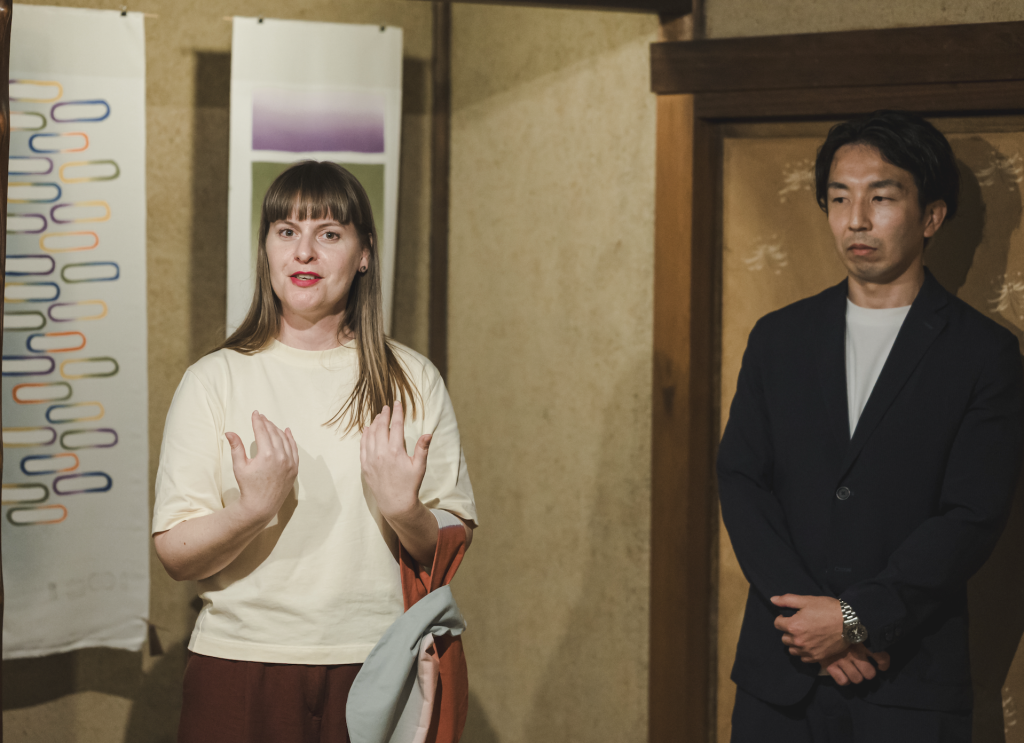
©Fuji Fumiya 2025
Future Goals
Ideally, I would love to build long-term collaborations with Japanese artisans. I want to show that I’m serious about this, by staying in touch, visiting regularly, being patient, learning more of the language and nurturing these relationships over time.
I would be thrilled to design a kasuri textile, or to reinterpret existing motifs in new colour compositions. I’m also very interested in exploring where innovation could happen within the process itself. Being an outsider allows me to bring a different perspective, and that can sometimes open unexpected doors.
I will definitely keep coming back to Japan. Each visit feels like another layer added to my practice, and to my personal life.
Since many crafts and local makers have disappeared in the Netherlands, and something similar is happening in Japan, I feel a strong sense of responsibility to contribute to preserving cultural heritage while keeping it alive and relevant. When tradition freezes, it quickly turns into a museum piece, or something designed only for tourists. For a craft to have a future, it must move, evolve and stay curious.
It’s heartening to see more Japanese craftspeople realising this, supported by local communities and municipalities. Shimogawa Orimono is a perfect example of how tradition and innovation can co-exist with care and respect.
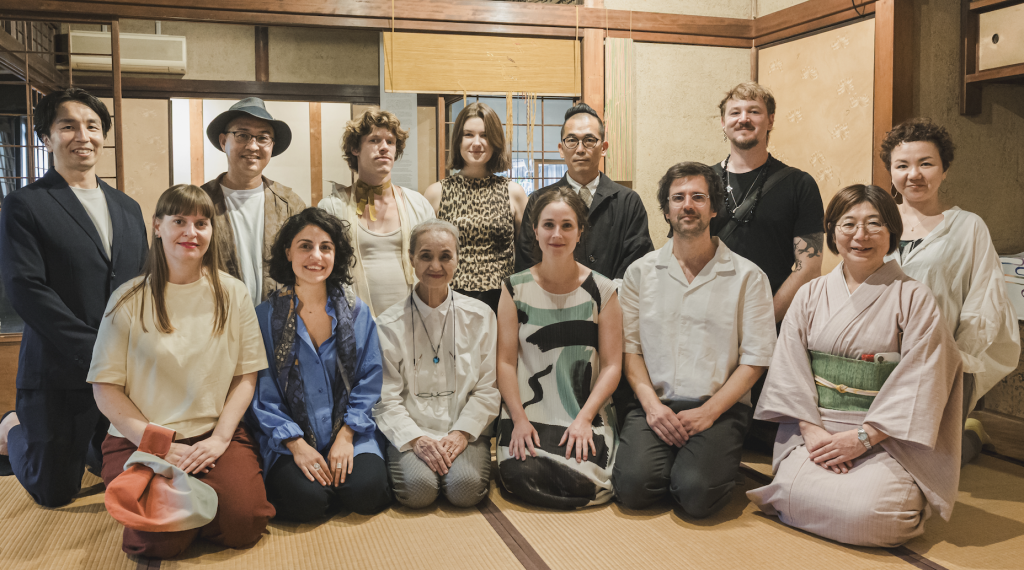
©Fuji Fumiya 2025
「10月2日に展覧会『Artisanal Intelligence』が開催されました。
これは、大阪万博2025において欧州連合パビリオンのために@knotto.worldが企画した国際共同プロジェクトです。
この機会に、5人のヨーロッパのアーティスト、デザイナー、キュレーター、職人が日本各地に派遣され、5人の日本の職人と1か月間の密な共同制作を行いました。
www.knotto.world
info@knotto.world
RPR ブリュッセル
KNOTTO – AISBL
アルザス・ロレーヌ通り18番地 1050 ブリュッセル、ベルギー
CBE番号:1022856783」
自己紹介
私の名前はローラ・ルフトマン(Laura Luchtman)と申します。オランダ・ロッテルダムを拠点に活動するテキスタイルおよびサーフェスデザイナーです。私のスタジオ「Kukka」では、色とテキスタイルの社会的・文化的・生態的な側面を探求しています。
私の仕事は、色素を生成するバクテリアや外来植物(たとえばクズなど)を使った染色のような非常に実験的な自主研究から、ファッションやインテリアブランド向けの色やパターン開発まで、多岐にわたります。
学問的にはコミュニケーションとファッションを学び、さまざまな企業でインハウスとして働いた経験を通じて、徐々に自分自身の独立した実践を形づくってきました。私は多様なことに興味があり、さまざまな素材、技法、プロジェクトに身を置くことを好みますが、「色」と「テキスタイル」は、私の仕事を通じて常に通底するテーマです。
私のスタジオでの1日は毎日違います。おそらくそれは下川さんと共通している部分だと思います。彼もまた、工場で実際に手を動かし、汚れ仕事をし、デスクワークに切り替え、来客を迎え、サンプルを準備し、展示会に参加するなど、非常に多面的に活動しています。そのリズムには親しみを感じます。
唯一の違いは、私は従業員を雇っておらず、自ら布を生産していないことです。私はコンセプト、デザイン、サンプル、プロトタイプを作り、生産は職人やメーカー、ブランドと協働して行っています。
日本への関心
日本への憧れは2004年、ファッションの勉強を始めた最初の年に芽生えました。当初は主に日本のファッションやストリートスタイルに興味を持っていましたが、それは徐々により広い文化的関心へと発展しました。
2016年には、ロッテルダムで行われたワークショップに参加し、日本の藍染、刺し子、絣の糸染め、絞り染めを学びました。控えめな入門ではありましたが、それが深い好奇心を呼び起こし、後にいくつかの染色プロジェクトや日本訪問へとつながりました。
初めて日本を訪れたのは2018年で、その時にはすでにテキスタイル技法に強い関心を持っていました。滞在中は、京都の絞り博物館や織成舘帯織工房などを訪問しました。そのときすぐに「もっと長く日本に滞在したい」と思いました。多くの違いがあるにもかかわらず、日本はなぜか懐かしいような感覚を与えてくれました。そしてオランダに戻ると、音、匂い、味といった小さな感覚的な要素が恋しくなるのです。
自宅では日本を思い出す小さな習慣を続けています。土曜の朝には、同じく日本に魅了されているシェフでありビアソムリエのパートナーと一緒に、うどんを食べながらYouTubeで日本の動画を見るのが定番です。単純な習慣ですが、日本とのつながりを保つ大切な時間です。
それ以来、私は2020年、2023年、そして今回2025年と、日本を再訪しています。今回は一人で、仕事としての滞在です。
2020年には山梨の織物地域を訪れ、「絵絣」(久留米絣のように糸を括るのではなく、経糸の柄を印刷する技法)や「ほぐし織」の技法について学びました。
日本でレジデンスを行うのは長年の夢であり、ついに今年その夢が実現しました。京都の加藤賢フラッグスタジオ/kiten.kyotoで、伝統と現代の両方の職人とともに、織り、刺繍、染色に取り組みました。
この「Artisanal Intelligence」プロジェクトは、5名のヨーロッパのアーティスト、デザイナー、職人、キュレーターが日本で1か月間滞在するもので、大阪万博EUパビリオンの文化プログラムの一環として、Knottoが企画し、EUと在日オランダ大使館の支援を受けて実現しました。下川織物もこのプロジェクトに参加し、ブルガリアのデザイナーと協働されていました。
本来は風呂敷をテーマにしたプロジェクトを続けるために滞在を延長する予定でしたが、助成が得られなかったため、計画を変更しました。当初は山梨と八女の両方を訪れるつもりでしたが、最終的に八女に焦点を絞り、まだ訪れたことのないこの地で1週間半を過ごすことにしました。そのおかげで、短い訪問では得られない深い体験ができています。
絣への関心
私は長い間、絣(イカット)に興味を持ってきました。主にそのグラフィックな柄や繊細な色の移ろいが、自分の作品にも通じる要素だからです。
2019年には、オランダで開催されたインドネシアのイカットと日本の絣に関するイベントに参加しました。そこでは、下川織物がオランダのデザイナーと協働していました。
その興味が伝染したのか、2020年にはCCD-NLから招かれ、下川さんと3本のウェビナーを共同制作しました。テーマは久留米絣の過去・現在・未来についてです。多くのアイデアを交換し、2年前には「Mono Makers Program」にも共同で応募しましたが、まだ実際の素材コラボレーションは実現していません。それでも連絡は続けており、ずっと工場を訪ねることを願っていました。職人が自らの現場を公開することは稀だからです。
オランダでは家族経営の小規模工場はほとんど姿を消しました。残っているのは大規模で産業化された工場ばかりで、外部の人を入れず、工程も厳重に守られています。デザイナーが見学や実験をすることは、生産時間の損失につながるため、彼らにとって現実的ではありません。
絣の工程は非常に多くの段階があり、遠くからでは抽象的にしか理解できません。今ここにいて、実際に体験できることによって、そのリズム、美しさ、限界、そして可能性を感じ取ることができます。
私のキャリアの中で、伝統的な技法や模様が「トレンド」として表層的に扱われ、その文化的な深みを失ってしまうことに何度ももどかしさを感じてきました。
プリントデザイン会社で働いていた頃は、毎週月曜日に新しいトレンドブリーフが届き、「今週はキリム、来週はイカット、その次はアステカ模様」といった具合でした。由来を調べる時間もなく、複雑で意味のあるものを単なる美的パターンとして再生産するだけでした。
今はそうしたやり方から距離を置き、文化的背景を尊重しながら、好奇心と敬意を持って技法を探究しています。今回の絣もまさにその一環であり、発祥の地で今も息づく文化に直接触れています。
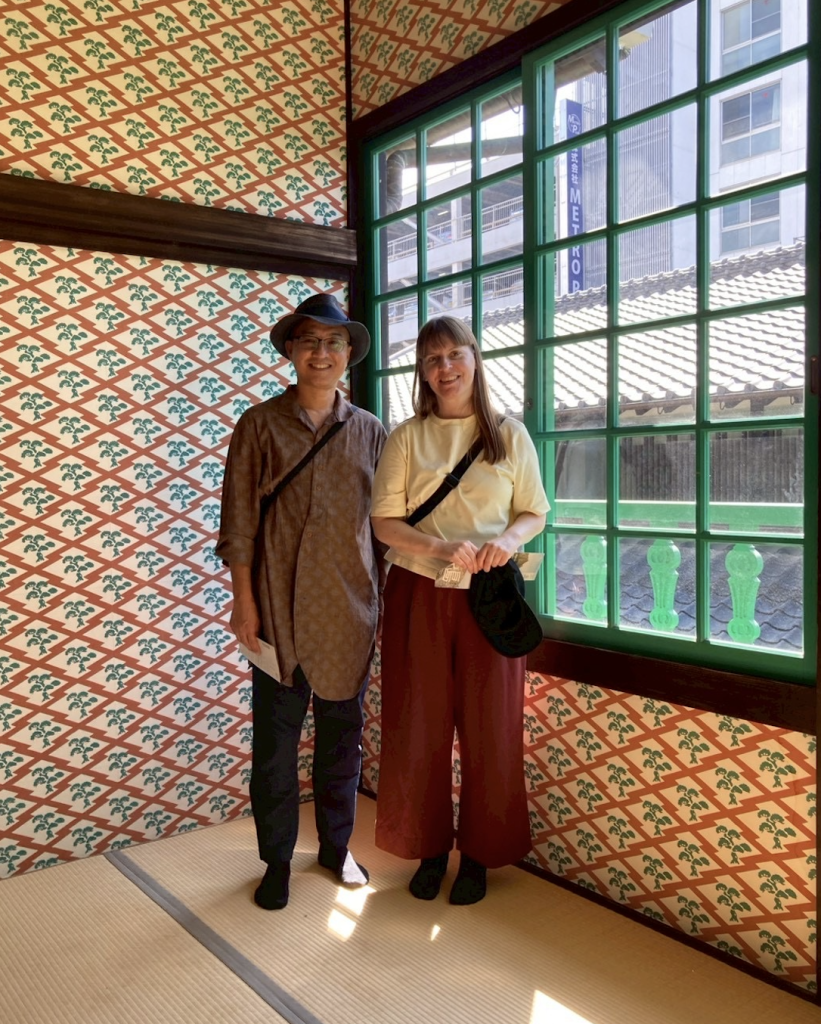
下川織物を訪れる理由
今回の訪問の主な目的は「関係を築くこと」です。絣の可能性と制約をより深く理解するために、実際の工程を観察し、参加したいと思いました。そして理想的には、この体験から新たなコラボレーションが生まれることを願っています。
今週は下川さんと行動を共にし、商談や取引先訪問に同行し、織りの現場を見学し、手作業で整経を手伝い、屋外で括り糸をほどく作業にも参加しました。そのすべてが非常に刺激的で、工程のつながりの美しさを実感しています。また、「Kasuri Village」という構想についても詳しく学びました。工場の皆さんやご家族がとても温かく迎えてくださり、本当に感謝しています。
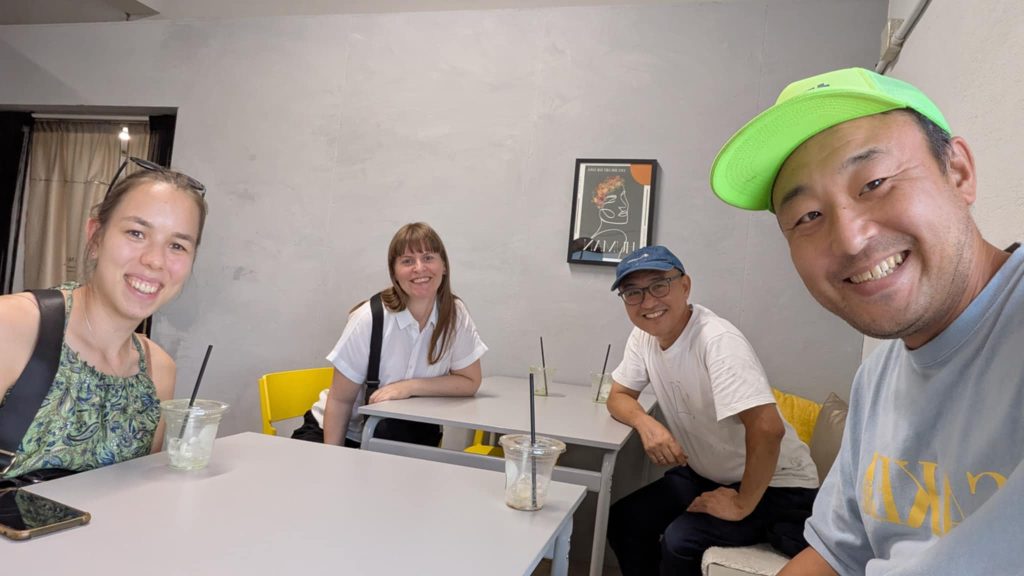
滞在の印象
私が特に興味深く感じたのは、かつて久留米絣が非常に革新的な存在だったという点です。手作業の一部を機械化するための専用機械が開発され、たとえば今でもインドネシアでは完全に手作業で行われている部分が自動化されていました。
しかしその後の技術開発はやや停滞しているようにも感じます。100年以上前の織機が今も使われているのは、その品質の高さを示す一方で、維持や操作の難しさも浮き彫りにしています。交換部品の入手が難しく、職人が引退しても後継者がいないため、知識の継承が危ぶまれています。布幅が狭く、和装用に設計されているため、現代的または国際的な用途に制約がある点も課題です。
だからこそ、国内外のデザイナーと協働する下川さんの開かれた姿勢はとても重要だと思います。デザイナーは、伝統が「完璧」を求めて見落としていた美しさ──たとえば柄のわずかなズレなど──を新たな価値として見いだすことができます。
私は、自然素材と最小限の化学薬品しか使わない点に強く感銘を受けています。同時に、「どの工程を手作業で行うことが本当に価値を生むのか」を改めて考えさせられます。
特に、絣づくりにおける多様な「結びの技法」に魅了されています。括りだけでなく、かせや経糸、糸束など、あらゆるところに「結び」が存在します。短い滞在の中でも、それらを記録に残したいと感じています。
経糸の合わせ方の精密さには心から驚きました。それ自体がひとつの工芸です。
下川さんの息子さんが、現代的な発想を取り入れながら事業を継承されるというのも素晴らしいことだと思います。そして、若い女性の織り手たちが、母親業や家庭と両立しながら仕事を続けていることにも深く感銘を受けました。
それぞれ異なる時間帯で働くことができる柔軟な環境が、若い世代がこの仕事を続けられる鍵になっていると思います。
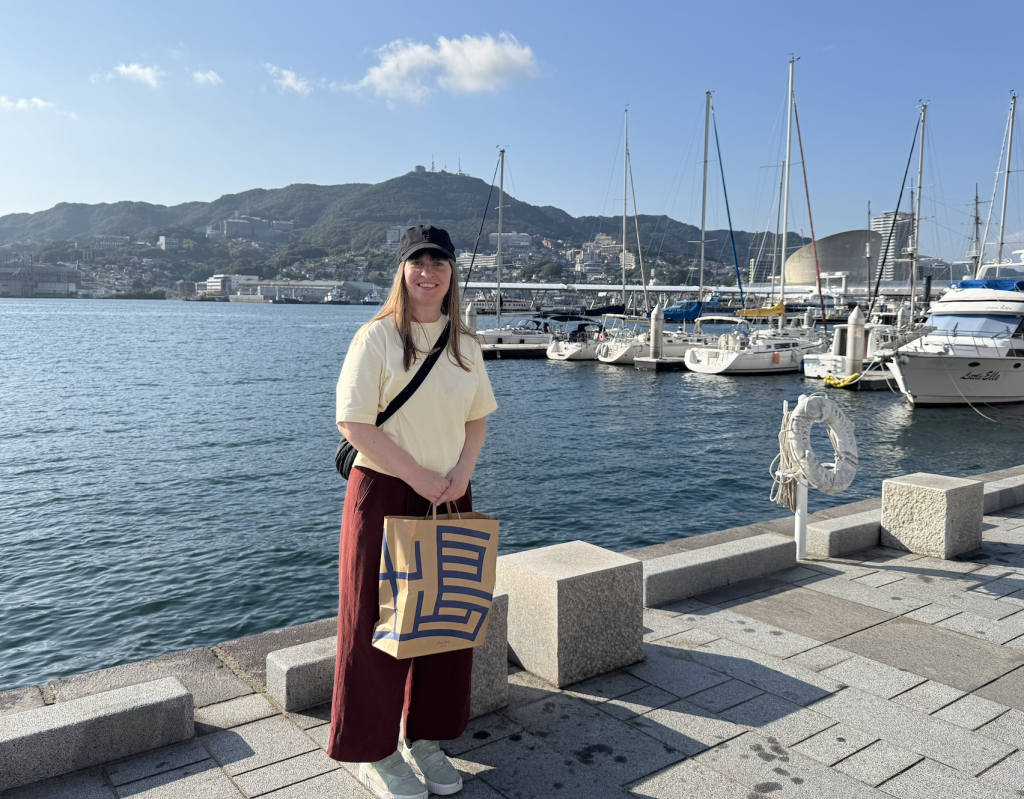
今後の目標
理想的には、日本の職人たちと長期的な協働関係を築きたいと考えています。そのために、連絡を取り続け、定期的に訪問し、言語を学び、時間をかけて関係を育てていきたいと思っています。
いつか、自ら絣のテキスタイルをデザインしたり、既存の文様を新しい配色で再解釈したりしたいです。また、制作工程そのものの中に革新の余地がどこにあるのかを探ることにも関心があります。外からの視点を持つことで、思いがけない扉が開くこともあると信じています。
私はこれからも日本に通い続けます。訪れるたびに、自分の創作活動にも、個人としての人生にも、新たな層が加わっていくように感じます。
オランダでは多くの工芸や地元の作り手が姿を消しており、日本でも同じことが起こりつつあります。だからこそ、私は文化遺産を守りながら、それを生きた形で未来につなげる責任を感じています。伝統が動きを止めると、すぐに博物館の展示物や観光向けの商品になってしまいます。
伝統が未来を持つためには、動き、進化し、探求し続けることが必要です。
最近では、地域社会や自治体の支援を受けながら、こうしたことに気づき始めている日本の職人たちが増えているのを目にします。下川織物はまさに、伝統と革新が敬意と配慮をもって共存している好例だと思います。
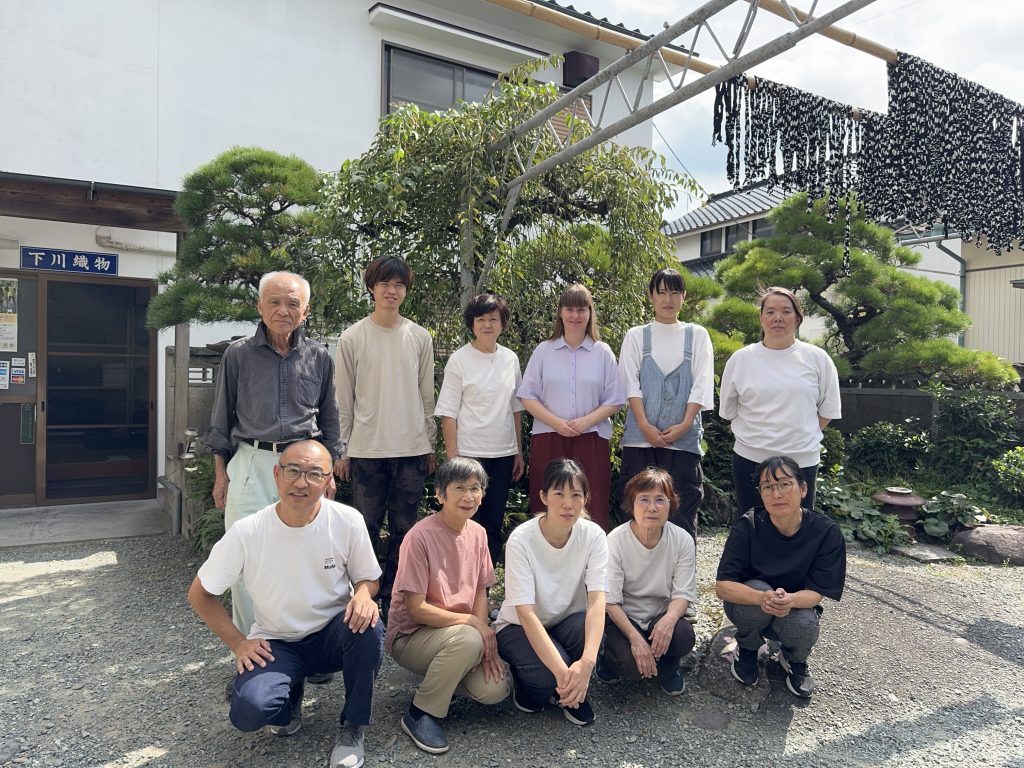
ローラ・ルヒトマン さん
遡ると2020年にウェビナーで共同制作したのが、ご縁になる。その間も定期的にご連絡いただき、彼女が、日本、絣、下川織物との関係性を大事に思っていただいているのを感じた。今回、初めてお会いして下川織物にも訪問、滞在していただくことになったが、あっという間に10日間の滞在が終了した。絣のプロセスは30行程もあり、その全てを短期間で伝えることが難しい。その課題を何らかの形で工夫していきたいと思う。近い将来、彼女とのコラボ作品を発表したいと思ってます。
久留米絣織元 下川織物
E-MAIL info@oriyasan.com
instagram https://www.instagram.com/shimogawakyozo/
facebook https://www.facebook.com/shimogawaorimono
YouTube https://www.youtube.com/channel/UCOZennIqkscFGNJLwnTOyKg